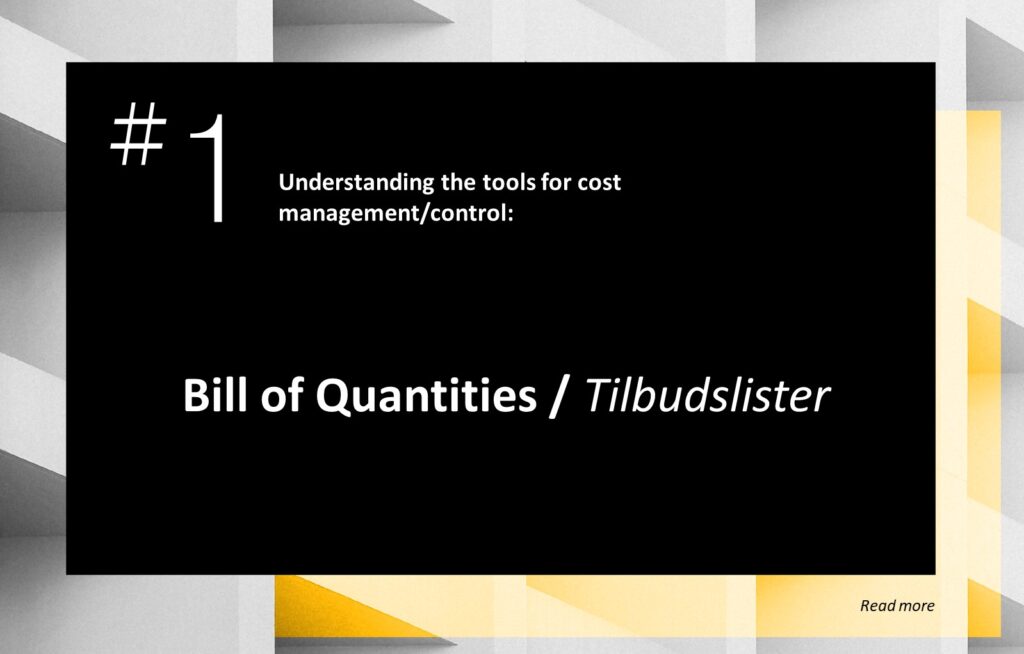1 – Det har altid været der…
Økonomi har altid være et fokuspunkt i hvilket som helst agenda som vi støder på i vores hverdag …
- I Coronakrise kommer Økonomikrise lige ’hånd i hånd’ med Sundhedskrise og Socialkrise, og konsekvensen af en økonomikrise kan blive enormt meget større og længerevarende end en sundhedskrise.

- I et projekt er styring af Økonomi lige så vigtig som styring af projektets Kvalitet og Tid

- Og i et bæredygtigt byggeri er Økonomi en af grundlæggende fundamenter, sammen med Miljøog Social

2 … Men der er endnu ikke nok fokus …
Når man kigger nærmere på den dansk byggebranche, kan man tydeligt se at økonomistyring ikke er blevet fokuseret nok. Dette gælder både bemanding af ressourcer til økonomistyring, og fokus på økonomi i projektstyrings dagsorden.
- I tidlige faser af projektet, dvs. forundersøgelse og byggeprogram, er der ikke eller er ikke nok involvering af økonomi specialister / Cost Manager til at lave økonomisk analyse for forskellige ’optioner’ og sætte et robust budget. Dette kan medføre alvorligt konsekvens for projekt pga. det stramme budget i hele forløbet af projektet i projekterings- og udførelsesfasen.
- I projekteringsfasen, dvs. dispositionsforslag + projektforslag + hovedprojekt, det normale projekteringshonorar bør være mellem 8%-12% af byggeudgifter, herunder plejer budget for økonomistyring normalt være afsat mellem 0,25%-0,45% af byggeudgifter. Dette er helt sikkert en for lille andel. Efter min mening skal Cost Manager have dybere og mere omfattende involvering i projekteringsprocessen, tæt og hypet dialog med disciplinledere, styring af økonomiske påvirkning grundet ændringer, samt udarbejde en højkvalitet tilbudsliste. Derfor en fornuftig procentsats til økonomistyring skal være mellem 0,75%-1,0% af byggeudgifter. Husk at økonomi er en af hovedårsager for om-projektering, budgetoverskrivelse, eller det værst tænkbare – projektet bliver aflyst pga. tilbuddet er meget højere end budgettet!
- I udførelsesfasen er mange projekter økonomistyring udført af byggeleder eller en ingeniør/bygningskonstruktør/økonom. Denne uprofessionelle ordning kan gå helt galt, fordi der mangler en erfaren Cost Manager til at udarbejde et ordentligt byggeregnskab, styring af risiko og UFO pulje, vurdering af entreprenørers faktura og krav holdt op imod kontrakt, tilbudsliste, og byggefremdrift. Husk at det afsluttende regnskab for et byggeri løber en langt større risici at ende meget højere end tilbuddet i licitationen og kontrakten hvis der ikke er en ordentlig økonomistyring, og økonomisk konflikt kan medføre dårlig kvalitet og forsinkelse af projektet.
F.eks. med en ’traditionel’ procentsats 2% af byggeudgifter for byggeledelse, herunder økonomistyring, regner man ca. 10% UFO for entreprenørs krav og ekstraarbejder (sum 12%). Hvis bygherre fordobler byggeledelse budget til 4%, kan UFO potentielt reduceres til 5% (sum 9%). I alt er der reduktion af 3%, samtidigt kan man potentielt forhøje projekts kvalitet og beholde projekts tidsplan, og gøre alle parter i projektet glade – bygherren, totalrådgiver, og entreprenør.
I sidste ende er økonomi et af det fokuspunkt i et projekt succeskriterier, og det fortjener mere fokus og opmærksomhed.


